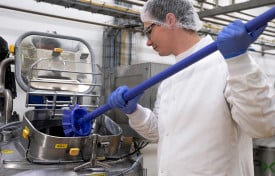E.coli

- January 13, 2016
When preparing 3M™ Petrifilm™ for use in your environmental monitoring program there are different hydration methods to follow, depending on the test and the context in which it is used.
For air or direct contact procedures where Aerobic Count, Coliform Count, E.coli/Coliform Count, Rapid Coliform Count or Enterobacteriaceae Count Petrifilm™ are being used, hydrate plates with 1 mL of appropriate sterile diluent. Allow hydrated plates to remain closed for a minimum of 1 hour before use. If using Staph Express Count Petrifilm™, hydrate plates with 1 mL of appropriate sterile diluent. Refrigerate hydrated plates for a minimum of 3 days before using.
For air testing using either Yeast and Mold Count or Rapid S. aureus Count Petrifilm™, hydrate plates with 1 mL of appropriate sterile diluent. Allow hydrated plates to remain closed for a minimum of 1 hour before use.
- January 21, 2015
“You could also ask who’s in charge. Lots of people think, well, we’re humans; we’re the most intelligent and accomplished species; we’re in charge. Bacteria may have a different outlook: more bacteria live and work in one linear centimeter of your lower colon than all the humans who have ever lived. That’s what’s going on in your digestive tract right now. Are we in charge, or are we simply hosts for bacteria? It all depends on your outlook.” - Neil deGrasse Tyson, Space Chronicles: Facing the Ultimate Frontier.
As funny as that may sound and as puzzling as it may be to think about, it is true. Bacteria are everywhere; most of them are good and normal and are absolutely necessary for the maintenance of our health, environment, and well-being. They are responsible for some of the best things (in my book) in life…like cheese, beer, and wine. But when the wrong bacteria get into our food supply, the results can be disastrous.
Historically, testing for the presence of what is known as an indicator organism in our water and food supply, has played a significant role in the food industry. These levels are monitored as indicators of food quality, food safety, and a marker of the overall hygienic status of the production facility. E.coli, Coliforms, and Enterobacteriaceae are three indicators that have been, and are currently used in the industry.
In 1887 a well-known bacteriologist, Theodor Escherich, observed a pervasiveness of organisms now known as Esherichia in human stools. Later, E.coli and other organisms were used to indicate the potential presence of pathogens in water. In 1915, the U.S. Public Health service changed this standard indicator from E.coli to Coliforms. Using E.coli and Coliforms as indicators of water safety and quality eventually spread to testing for these organisms in other foods. First, pasteurized milk and dairy products were tested and then an array of other foods followed.






